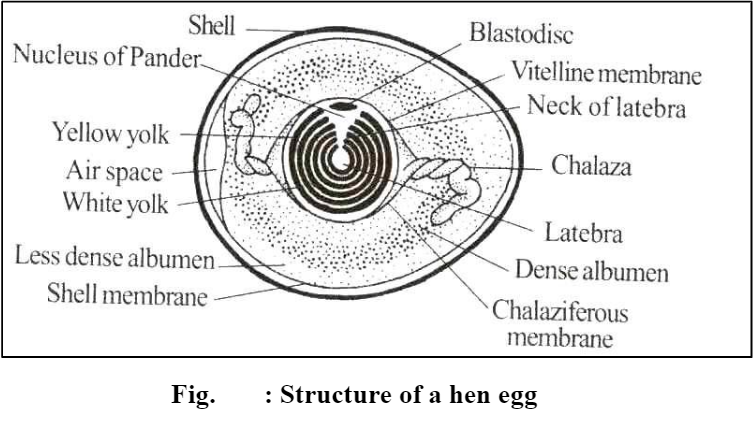Structure of Hen’s egg:
The fully formed and newly laid fertilized egg of hen is a large elliptical body with one end broader than the other. It is about 3 cm broad and 5 cm long with its enormous mass of yolk, is an extreme example of polylecithal (macrolecithal) egg.
An egg basically consists of three parts:
1. a shell 2. an egg white 3. an egg yolk
Ex.: An egg from a hen consists of approximately 2/3 egg white and 1/3 egg yolk.
The yolk is well-centered in the albumen and is surrounded by the vitelline membrane, which is colorless. The germinal disc, where fertilization takes place, is attached to the yolk. On opposite sides of the yolk are two, twisted, whitish cord-like objects known as chalazae. Their function is to support the yolk in the center of the albumen. Chalazae may vary in size and density, but do not affect either cooking performance or nutritional value.
A large portion of the albumen is thick. Surrounding the albumen are two shell membranes and the shell itself. The shell contains several thousand pores that permit the egg to “breathe.”
The egg shell
The shell is built of 8-10,000 pores, which ensures that oxygen can penetrate and CO2 and other gases can escape. The shell represents about 10 % of the weight of the egg and consists mainly of calcium carbonate and calcium phosphate. The shell thickness and thus the strength depends on egg size, breed, the age of the hen, and feed composition. Only the outer layer of the shell is coloured. The colour of the shell can be white or brown — depending on the breed. A white hen lays white eggs and brown hens lay brown eggs. There are also white hens that lay brown eggs but this breed is currently not being used for production in Denmark.
The egg white. The egg white represents approx. 60 % of the weight of the egg and consists of 88 % water and 12 % dry matter, primarily protein. The white is divided into three parts: an inner and an outer liquid layer, and in between those a liquid layer with a thicker consistency. The white prevents external bacteria from penetrating the yolk. The pale yellow-green colour of the white is due to the presence of riboflavin (vitamin B2). In completely fresh eggs there are lots of small air bubbles, which can give the egg white a dull milky appearance. This is because of carbon dioxide that has not yet leaked out through the shell. The older the egg. the more transparent the egg white.
The egg yolk
The yolk is held in place by two screw-shaped egg white strands – the chalazae. The yolk is not homogeneous but consists of alternate layers of yellow and white yolk. The layers of yellow yolk are thicker than those of white yolk. The yellow colour of the yolk is due to the presence of yellow carotenoids. The central flask-shaped mass of white yolk is termed, latebra, while its outer neck, is known as the neck of latebra, which expands under the surface of blastodisc into a broad area, called the nucleus of Pander.
Most of the yolk is liquid, but about 23% of it is in the form of a solid-yolk- sphere. The yolk as a whole contains 48.7% water: 32.6% phospholipids and fats, 16.6% protein, 1% Cholesterol, and 1.1% other chemical molecules including vitamin A, B, B6, D, and E. The fat content consists primarily of triglycerides, cholesterol, and phospholipid lecithin. The amount of fat and cholesterol and the composition of the fat is influenced by the diet of the hen. The Carbohydrates of the yolk are free glucose and polysaccharides.
Shell membranes
Under the shell, there is an outer and an inner shell membrane. The outer membrane, which is immediately inside the shell, is the most resistant. Besides serving a packaging role, the shell and the shell membranes also have a biological function; namely to regulate evaporation and air circulation, but also to prevent penetration of microorganisms. A colorless wax membrane called the cuticle surrounds the outer shell. It is highly alkaline and therefore acts bacteriostatic.
Air cell When the egg leaves the hen, it has a temperature of 39°C. When it is cooled, there is a contraction of the contents and air can penetrate through the shell. In the heavy end of the egg, the outer and the inner shell membrane are split and the air cell is formed here. The older an egg is, the larger the air cell, as water continuously evaporates from the egg during storage.

